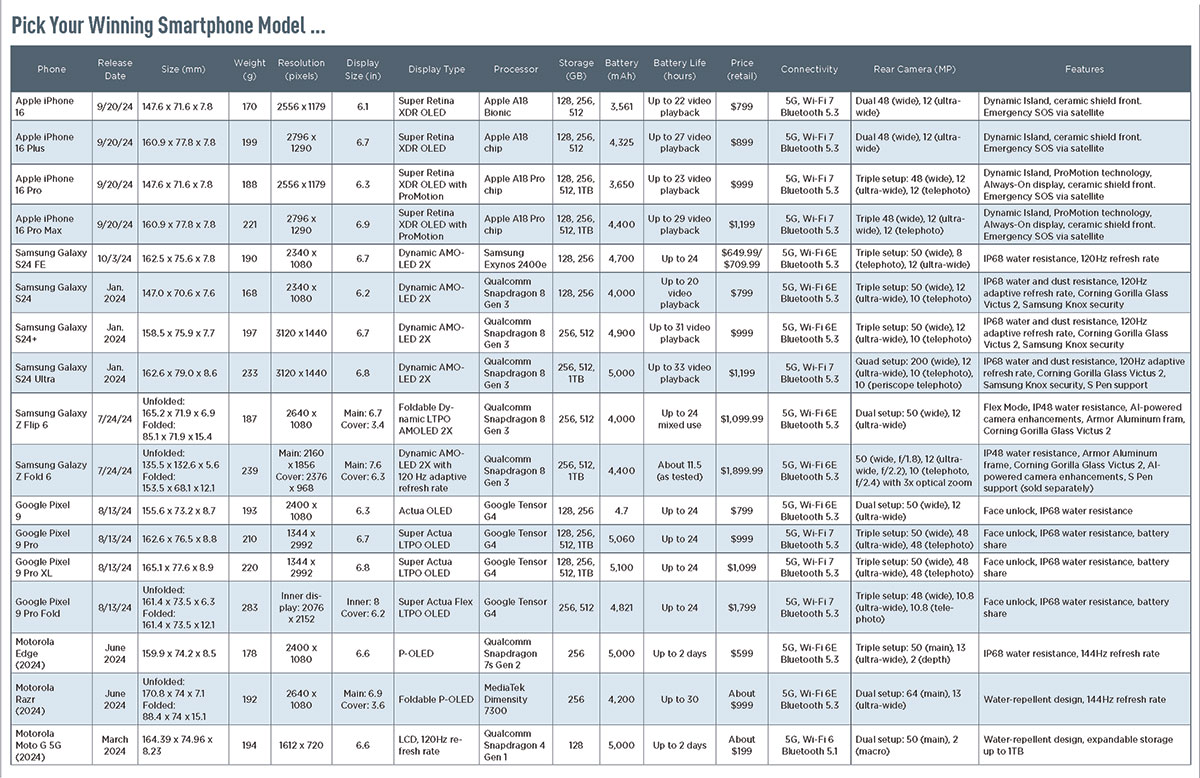
While artificial intelligence (AI) has dominated the headlines for the past few years, not a single respondent to my informal survey of Wisconsin lawyers made AI a vital feature when selecting a phone. Nonetheless, because every phone manufacturer has included AI, it’s important to discuss how manufacturers integrate AI and its security.1 This analysis primarily focuses on this year’s top manufacturers: Apple, Google, Samsung, and Motorola. These are the brands repeatedly identified as the most popular among the lawyers surveyed.
Performance & Battery Life
Do new models have better performance and longer battery life than what they replace? We’ve all experienced how technology tends to slow down as it ages. Most lawyers surveyed keep their phones for at least three years.
 James Pearson owns the Computer Center, Janesville. He is a Microsoft Certified Professional and a frequent author and speaker on cybersecurity and safety topics. thelawyersgeek.com
James Pearson owns the Computer Center, Janesville. He is a Microsoft Certified Professional and a frequent author and speaker on cybersecurity and safety topics. thelawyersgeek.com
This year, Apple introduced an interesting comparison calculator on its website. Because many respondents tend to keep their phones for over three years, I used the iPhone 12 for comparison. Transitioning to the iPhone 16 or 16 Plus offers an additional five hours of video playback, potentially up to 10 hours more than the iPhone 12, highlighting a significant improvement in battery performance.
Additionally, Apple’s tool allows users to assess performance enhancements, revealing that those currently on the iPhone 12 can expect an overall performance boost of up to 60% with the latest processors. The iPhone 16 and iPhone 16 Plus can operate at twice the speed of the iPhone 12, resulting in substantial improvements in efficiency and performance. These advancements lead to a significantly enhanced experience compared to the iPhone 12.
Although this tool is specific to Apple’s products, users can typically expect similar advancements in performance and efficiency when upgrading from older models, especially those three to five years old, regardless of the manufacturer. These improvements suggest it might be worth upgrading.2
The Pixel 9 Pro stands out with its impressive battery life, lasting up to 100 hours with its extreme battery-saver mode. This feature, which conserves energy by disabling features such as 5G connectivity, is a unique selling point of the Pixel 9 Pro.
According to Samsung, the Z Flip 6’s battery life is 66 hours for audio playback and 23 hours for video playback, significantly less than that of the Z Fold 6, which boasts an impressive 77 hours of audio playback. Meanwhile, the S24, with its smaller screen, provides 72 hours of audio playback and 28 hours of video playback.
Storage Capacity
Storage capacities have mostly stayed the same in recent years. Most smartphones today offer standard storage ranging from 128 GB to 512 GB.
Google’s Pixel 9 Pro stands out once again by offering an impressive one terabyte (TB). However, the rest of the phones in the Pixel 9 lineup max out at 512 gigabytes (GB). Samsung’s latest offerings, including the Z Fold 6, Z Flip 6, and S24, vary in storage. The Z Fold 6 has 1 TB of storage, matching the Pixel 9 Pro, while the Z Flip 6 is limited to 512 GB. The S24 offers options for 128 GB and 256 GB.
Manufacturers likely will continue prioritizing cloud storage over enhancing device storage. For instance, even with Apple’s push for video capabilities, its top storage option is 1 TB, exclusive to the 16 Pro model, while other models max out at 512 GB.
Screens
When I started selling computers about 35 years ago, I told a client, “This new model has everything you will ever need.” Now, the devices we carry in our pockets have more power than a room full of those old PCs. Having a screen that fits your needs can make a difference in how much you use your phone and how long the battery lasts.
For the largest and best screens that provide a more expansive workspace for writing, browsing, watching videos, or even graphic design, consider the flip or fold models from Samsung or Google. For the ultimate screen size, the Google Pixel 9 Pro Fold features a massive 8-inch inner display, the largest in this year’s list.
The Samsung Galaxy Z Flip 6 ranks second with a 6.7-inch unfolded display. In contrast, Apple’s iPhone 16 Pro Max, with a 6.9-inch screen, is the largest nonfolding device available.
For more compact models, the Galaxy S24 and iPhone 16 are great options, featuring comfortable screen sizes of 6.2 and 6.1 inches. These choices cater to users who prefer a smaller screen without compromising functionality.
Artificial Intelligence
In a notable shift from previous years, Apple focused its marketing efforts on “AI for the rest of us” and how artificial intelligence will enhance its smartphones instead of its longstanding mantra of “Hollywood in your pocket.” Apple is not alone in this focus: Integrating AI into phones is at the top of every manufacturer’s list this year.
Key innovations include Siri’s improved capabilities, allowing it to manage multiple commands and better understand language. Users can now dictate messages with a single click, record voice notes, and even capture phone calls for transcription within native applications. There’s also new functionality for creating art. Siri will provide personalized assistance based on its understanding of individual contexts, making interactions more tailored and efficient.
Apple maintains a strong commitment to data privacy. Notably, even Apple cannot access user data, reinforcing its privacy stance. Information is not stored permanently but is processed in a secure environment using Apple’s Private Cloud Compute. Users can also choose whether to integrate ChatGPT tools within Siri, which ensures prior consent must be obtained before users’ personal information is shared.3
Pixel smartphones prominently feature manufacturer Google’s AI, Gemini, which is intended to operate seamlessly across apps such as Gmail and Google Maps. Gemini can create images and enables quick searches; if a user snaps a photo and circles an item, the AI will find relevant information. As with Apple’s AI, users can easily adjust photos on the spot, altering backgrounds.
Gemini also includes a built-in chat feature, Gemini Live, offering familiar chatbot functionalities.4 The Pixel 9 Pro boasts strong security features, including the Titan M2 coprocessor, machine-learning capabilities, face unlock, and a built-in VPN.5
Samsung’s Galaxy models are equipped with Galaxy AI, which can interpret phone calls and conversations in real-time. This feature is mainly beneficial with the Z Flip 6, enabling simultaneous translation on both sides of the screen. A phone user can set the Z Flip 6 on a surface with the inner and outer screens facing each person, providing an instant, real-time translator. In addition to conversation translation, these models offer photo-editing tools and note-taking capabilities to enhance communication.6
For enhanced security, Samsung incorporates a comprehensive platform known as Knox, which provides robust protection from boot up and beyond. This platform offers end-to-end encryption for data syncing and cloud backup. It includes features like Knox Vault and Knox Matrix, which enhance data protection.7
Key Survey Findings
As mentioned, I request informal feedback from Wisconsin’s legal community each year regarding smartphone usage and habits. It’s a revelation as to how responding lawyers use technology. This year, I published the survey to show the raw results.8
Interestingly, the results stay consistent year over year. For example, iPhones have dominated Android. Further, only a few people change carriers more than once or twice in their lifetime.
Here are some additional survey statistics:
72% of respondents use Apple iOS, while 28% use Android. Samsung ranks first among Android brands, followed by Google and Motorola. Motorola usage has declined each year.
Most respondents rated overall satisfaction with their current phone at 4.3 (out of 5). About 68% keep their phones for more than three years, while 28% switch within that timeframe. Verizon and AT&T are the top providers, and many rate their providers below a 4 out of 5.
Coverage, data plans, and speeds are the top priorities when choosing providers. Only 16% have never changed providers, with 32% changing once, 24% twice, and 28% switching three times or more.
Top Picks
In conclusion, the 2025 smartphone lineup showcases remarkable advancements in battery life, performance, storage capacity, and display quality, reflecting the evolving needs of users. Although artificial intelligence integration might not be a deciding factor for many, it is now an integrated aspect of the latest models. Whether looking for improved performance and battery life, a low-cost replacement, or the phone with the most storage space, you can find something new in this year’s lineup.

Click to expand image.
Artificial Intelligence
Surprisingly, I found few reviews on smartphone AI implementation, and it’s hard to rate a feature without information about users’ personal experience with the feature. Because most users switch operating systems infrequently, I suggest not considering it now. From my experience, Apple protects data better than other manufacturers but at the expense of adopting new technology more slowly.
Battery Life
The Google Pixel 9 Pro is notable for its impressive battery life, lasting up to 100 hours when using its extreme battery-saver mode.
Budget Conscious
The most affordable smartphone on the list is the Motorola Edge (2024), priced at $599.
Camera
The Apple iPhone 16 is still “Hollywood in your pocket.” It features a dual-camera system with a 48MP wide lens and a 12MP ultra-wide lens.
The Motorola Moto G 5G (2024) features a dual-camera setup with a 50MP main lens and a 2MP macro lens.
Security
Apple’s iOS is well known for its robust security features. Its rigorous vetting process for apps, detailed privacy policies, and the App Sandbox – which limits what each app can access – make any of the Apple iPhone 16 series an excellent choice for security-conscious users.
I suggest the Google Pixel 9 series for Android users. It provides direct and timely security updates from Google, features a built-in Titan M security chip, and includes regular patches that enhance secure boot and storage.
Screen Size
Largest screen: The Google Pixel 9 Pro Fold features an impressive 8-inch inner display.
Smallest screen: The Apple iPhone 16 screen is the smallest, at 6.1 inches, unless you count the cover display on the Samsung Galaxy Z Fold 6, which measures only 3.4 inches.
Storage Capacity
The Google Pixel 9 Pro and the Samsung Galaxy Z Fold 6 are top choices for storage capacity, each offering up to 1 TB of storage. If you prefer Apple, the Apple iPhone Pro and Pro Max offer 1 TB of storage for movies and other video and audio.
Where to Get Product Specifications
All the websites below were last visited on Dec. 8, 2024.
Endnotes
1 The Lawyer’s Geek, https://www.thelawyersgeek.com/smartphonesurvey.
2 Apple iPhone 16 and iPhone 16 Plus, https://www.apple.com/iphone-16/ (last visited Dec. 8, 2024).
3 Android vs. iOS: Security Comparison 2024, NordVPN; https://nordvpn.com/blog/ios-vs-android-security/ (last visited Dec. 3, 2024).
4 Google, Gemini + Gemini Advanced on Pixel: Everything You Need to Know,https://store.google.com/intl/en/ideas/articles/gemini-advanced-features/ (last visited Dec. 8, 2024).
5 Google Safety Ctr., Google Pixel Privacy & Security Features, https://safety.google/pixel/ (last visited Dec. 8, 2024).
6 Samsung Business Insights, How Galaxy AI Secures Privacy and Data: A Guide for IT Leaders, https://insights.samsung.com/2024/07/16/how-galaxy-ai-secures-privacy-and-data-a-guide-for-it-leaders/ (last visited Dec. 8, 2024).
7 Samsung, Knox, This Is Protection, https://www.samsung.com/us/business/solutions/samsung-knox/?cid=com-btb-sky-blg-us-other-na-100219-112001-na-na-na&attributioncampaignid=701Hp0000026fwHIAQ (last visited Dec. 8, 2024).
8 To view the survey (all data is anonymous), download a copy at https://www.thelawyersgeek.com/smartphonesurvey.
» Cite this article: 98 Wis. Law. 39-44 (January 2025).
